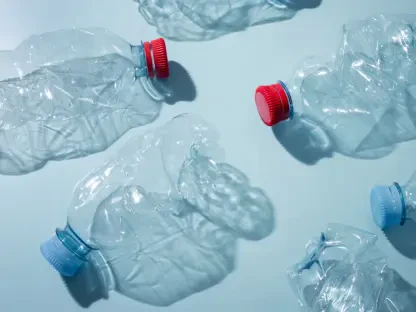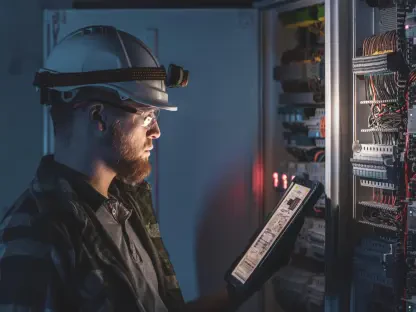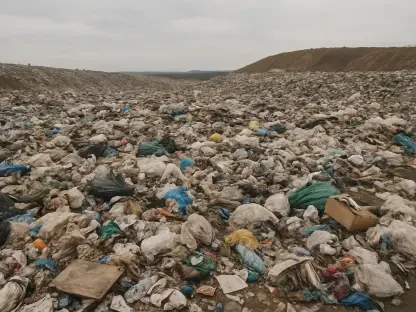In the heart of the Danish North Sea, a transformative project is taking shape that could redefine the landscape of renewable energy in Europe, promising a sustainable future. The Thor offshore wind farm, a colossal 1.1GW initiative led by RWE in collaboration with Norges Bank Investment Management, has reached a pivotal moment in its development with the completion of its foundation installation phase. This achievement marks a significant step forward for Denmark’s largest offshore wind project, promising to deliver clean energy to over one million households upon completion. As the global push for sustainable energy intensifies, this wind farm stands as a beacon of innovation and environmental responsibility, showcasing how large-scale projects can balance technological advancement with ecological care. The journey of this ambitious endeavor offers a glimpse into the future of green energy, highlighting both the challenges and triumphs of offshore wind development in a marine environment.
Progress and Milestones
Foundation Installation Success
The foundation installation for the Thor wind farm concluded in September, a landmark achievement that saw the placement of the final monopile, bringing the total to 72 for the wind turbines. This critical phase, executed over six months, was managed with precision using Van Oord’s specialized vessel, MPI Adventure, and coordinated from the Port of Thyborøn. Beyond the monopiles, the installation included secondary steel structures such as boat landings and access platforms, essential for safe and efficient operations. A standout feature of this phase was the deployment of innovative reusable hard covers to protect the foundations from harsh marine conditions until turbine installation begins. This approach not only ensures durability but also reflects a commitment to minimizing environmental impact during construction. The seamless execution of this stage underscores the importance of meticulous planning and logistical coordination in overcoming the unique challenges posed by offshore environments, setting a strong base for the next steps in the project.
The significance of completing the foundation phase extends beyond mere construction progress, as it establishes a robust framework for the wind farm’s future operational success. Each of the 72 monopiles represents a building block for clean energy generation, designed to withstand the relentless forces of the North Sea while supporting the massive turbines that will soon rise above the waves. The use of protective covers during this interim period highlights an often-overlooked aspect of offshore projects: the need for interim solutions that preserve infrastructure integrity. Moreover, the strategic choice of Thyborøn as a coordination hub illustrates how port infrastructure plays a vital role in facilitating large-scale renewable energy projects. This milestone is a testament to the collaborative efforts of all stakeholders involved, ensuring that every detail, from installation to protection, aligns with the overarching goal of sustainable energy production in Denmark and beyond.
Upcoming Construction Phases
Looking ahead, the Thor project is gearing up for its next major milestone with turbine installation scheduled to commence in early 2026 from the Port of Esbjerg. This phase will see the assembly of the wind turbines atop the already installed foundations, a complex operation that requires precision to ensure structural stability and operational efficiency. The choice of Esbjerg as the base for this activity reflects its established role as a key hub for offshore wind operations in the region, equipped with the necessary infrastructure to handle large components and vessels. Once completed, this step will bring the wind farm significantly closer to its operational target, projected for 2027, when it will begin supplying green electricity on a massive scale. The anticipation surrounding this phase underscores the project’s importance in meeting Denmark’s renewable energy ambitions and reducing reliance on fossil fuels.
In parallel with turbine installation, the construction of a new RWE service building at the Port of Thorsminde is underway, with completion expected by early 2026. This facility will serve as a critical operations and maintenance hub, supporting the wind farm’s long-term functionality and reliability. Beyond its technical role, the building is set to create 50 to 60 local jobs, injecting economic vitality into the surrounding community. This development highlights a broader trend in renewable energy projects where community benefits are increasingly integrated into planning, ensuring that the advantages of such initiatives extend beyond environmental gains. The dual focus on technical progress and local impact during these upcoming phases illustrates a holistic approach to project management, balancing the immediate needs of construction with the long-term benefits for both the environment and society.
Innovation and Impact
Sustainability in Design and Materials
A defining feature of the Thor wind farm is its pioneering approach to sustainability, setting a global benchmark for eco-friendly offshore wind development. This project will be the first of its kind to incorporate 36 steel turbine towers manufactured with a reduced carbon footprint, a significant stride toward minimizing the environmental impact of construction materials. Additionally, some of the turbines will feature recyclable rotor blades, addressing one of the industry’s persistent challenges—waste management at the end of a turbine’s lifecycle. These innovations reflect a growing recognition within the renewable energy sector that sustainability must permeate every aspect of a project, from design to decommissioning. By adopting such forward-thinking technologies, the Thor initiative not only enhances its environmental credentials but also paves the way for future projects to follow suit in prioritizing green practices.
The broader implications of these sustainable choices are profound, as they contribute to a shift in industry standards toward more responsible production methods. The reduced carbon footprint of the steel towers, for instance, challenges traditional manufacturing norms and encourages suppliers to innovate in their processes. Meanwhile, the use of recyclable blades tackles a critical issue of material disposal, offering a potential model for circular economy principles in renewable energy infrastructure. These efforts align with Denmark’s national goals of achieving carbon neutrality, positioning the Thor wind farm as a flagship project that embodies the intersection of technological advancement and environmental stewardship. As the project moves toward completion, its emphasis on sustainable materials serves as a powerful reminder that large-scale energy solutions can—and must—prioritize the planet alongside power generation.
Economic and Environmental Contributions
Once operational in 2027, the Thor wind farm is expected to generate enough green electricity to power over one million Danish households, a staggering contribution to the nation’s clean energy landscape. This capacity underscores the project’s role as a cornerstone in Denmark’s transition away from fossil fuels, supporting broader European efforts to combat climate change through renewable sources. The environmental benefits of this output are clear, as it will significantly reduce greenhouse gas emissions by displacing traditional energy sources with clean, wind-generated power. Such a scale of impact illustrates how offshore wind farms can serve as vital tools in addressing global energy challenges, offering a scalable solution that meets the demands of modern societies while safeguarding natural ecosystems.
Beyond its environmental contributions, the Thor project also delivers tangible economic advantages to the local region. The creation of jobs through the construction and operation phases, particularly with the new service building at Thorsminde, fosters economic growth and stability in coastal communities. This dual benefit—environmental and economic—reflects a consensus in the renewable energy sector that projects must deliver value on multiple fronts to gain widespread support. The partnership between RWE, holding a 51% stake, and Norges Bank Investment Management, with 49%, further exemplifies how collaborative funding models can drive ambitious initiatives forward, sharing both risks and rewards. As a result, the Thor wind farm stands as a model of how renewable energy projects can harmonize ecological goals with community prosperity, setting a precedent for future developments worldwide.
Reflecting on a Sustainable Legacy
Looking back, the completion of the foundation installation phase for the Thor wind farm marked a defining moment in Denmark’s renewable energy journey. This achievement, coupled with the innovative protective measures and logistical coordination, laid a solid groundwork for the project’s subsequent stages. The commitment to sustainability through low-carbon materials and recyclable components demonstrated a forward-thinking mindset that resonated with global environmental priorities. As turbine installation and operational milestones approached, the collaborative spirit among stakeholders, from RWE to local port authorities, proved instrumental in navigating the complexities of offshore construction. Reflecting on this progress, it became evident that the Thor initiative was not just about generating power but also about redefining how renewable energy projects could integrate community benefits and ecological care. Moving forward, the focus remains on ensuring that each phase builds on this legacy, offering actionable insights for future offshore wind farms to emulate in their pursuit of a cleaner, more sustainable world.









